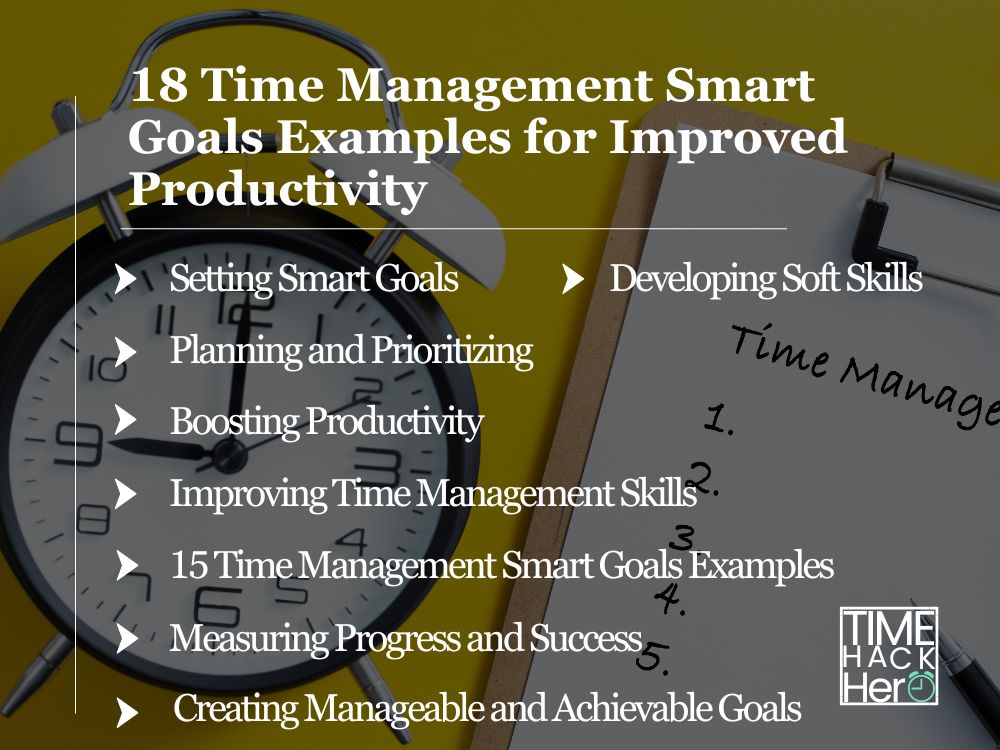
For those looking to enhance their time management skills, 15 Time Management Smart Goals Examples for Improved Productivity serves as a valuable resource. Throughout this article, we will explore various examples of achievable SMART goals that will provide a clear roadmap for individuals to follow, enabling better use of time and increased efficiency.
These SMART goals will target different aspects of time management, from organization and prioritization to adopting new habits and strategies. The well-rounded set of examples provided promotes the development of key skills and techniques that are essential for successful time management, ultimately resulting in boosted productivity and a more balanced lifestyle.
Table of Contents
Setting Smart Goals
Effective time management is crucial for improved productivity. One of the best ways to optimize your time management skills is by setting SMART goals. The SMART framework is an acronym that stands for Specific, Measurable, Attainable, Relevant, and Time-Bound. By creating SMART goals, you can develop a clear and actionable plan to achieve your objectives.
Specific
When setting a time management SMART goal, ensure that it is specific. Specific goals are well-defined and clear, making it easier to understand the desired outcome. A specific goal should answer the questions: Who, What, Where, When, and Why. For instance, instead of setting a goal like “I will finish my tasks more efficiently,” specify the goal like “I will complete my daily report in two hours.”
Measurable
To track your progress and determine whether you’ve met your objective, make sure your time management SMART goal is measurable. Measurable goals provide a way to evaluate the success of the goal by establishing concrete criteria. Examples include finishing a task within a set timeframe or increasing productivity by a certain percentage.
Attainable
An attainable goal is both realistic and achievable within the given constraints. While setting time management SMART goals, consider your current skills, resources, and limitations to ensure the goal is manageable. A helpful tip is to break down larger goals into smaller, achievable steps that can be completed sequentially.
Relevant
Relevance is an essential aspect of SMART goals, as it ensures that the objective aligns with your broader priorities. A relevant time management SMART goal contributes to your personal or professional growth and helps you improve your skills. For example, if prioritizing tasks is a challenge, set a goal to identify and focus on the most crucial tasks of the day.
Time-Bound
Lastly, time-bound goals are essential for effective time management. Set a deadline for your goal to maintain motivation and prompt timely action. By establishing a specific timeframe for completion, you can create a sense of urgency and prevent procrastination. For instance, instead of saying “I will start waking up early,” try “I will consistently wake up at 6:00 am for the next 30 days.”
By following the SMART framework and adopting these principles, you will enhance your time management skills, boost productivity, and achieve your objectives more efficiently.
Planning and Prioritizing
Objectives and Deadlines
In order to improve productivity through time management, it’s essential to set clear objectives and realistic deadlines. This means breaking down larger goals into smaller, achievable tasks that can be easily measured. Establishing specific, measurable, achievable, realistic, and time-based (SMART) goals provides a framework for planning and prioritizing these objectives.
- Set specific objectives that are clear and well-defined
- Ensure your goals are measurable through quantifiable outcomes
- Make your objectives achievable within your available resources and constraints
- Keep your goals realistic and aligned with your overall plans
- Assign time-based deadlines to stay accountable and focused
Resources and Support
Once you have defined your objectives and deadlines, it’s crucial to identify and allocate the necessary resources and support to accomplish your goals. This may include:
- Identifying tools and technology to aid in organization and time management (e.g., time tracking software, task management apps)
- Delegating tasks and responsibilities to team members, where applicable
- Seeking mentorship, training, or skill development opportunities to enhance your time management abilities
- Establishing a network of support, such as colleagues or friends, who can help keep you accountable and motivated
Action Plans and Timelines
Creating detailed action plans and timelines helps increase productivity and ensures that you’re able to track progress and adjust as necessary. An action plan should outline the steps required to achieve your objectives while a timeline provides specific deadlines for each task. Consider implementing the following steps:
- Identify steps: Break down objectives into smaller tasks or milestones
- Prioritize tasks: Rank tasks by importance or urgency, and allocate time accordingly
- Allocate resources: Assign necessary tools, team members, or support to each task
- Set deadlines: Establish time-based deadlines for each task to create a sense of urgency
- Monitor progress: Routinely evaluate your progress and adjust plans as needed
Using these guidelines, you can develop a robust plan for improving time management and productivity. Remember to regularly review and adjust your objectives, resources, and action plans to ensure consistent progress towards your goals.
Boosting Productivity
Task Management
Effective task management is crucial to improving productivity. One way to achieve this is by creating a to-do list containing specific, prioritized tasks to complete throughout the day. This allows you to focus on the most important tasks first and helps prevent procrastination. Additionally, utilizing the Pareto Principle (focusing on the 20% of tasks that yield 80% of the results) enables you to work more efficiently. Remember to regularly update your list as tasks are completed and new ones are added.
Eliminating Distractions
Distractions are one of the biggest obstacles to productivity, so it’s essential to eliminate them. Here are a few strategies to help you focus:
- Set boundaries: Inform those around you about your work hours and ask them not to disturb you during that time.
- Limit digital distractions: Turn off unnecessary notifications on your phone and computer. If needed, use apps that block distracting websites.
- Create a conducive environment: Keep your workspace organized and clutter-free. This enhances focus and encourages efficiency.
Taking Breaks
Taking breaks may seem counterintuitive to productivity, but they’re actually beneficial in maintaining a high level of focus and efficiency. Here’s why:
- Breaks allow your brain to rest and recharge, improving overall mental function.
- Stepping away from a task for a short period can often lead to new insights or solutions.
- Physical movement during breaks increases blood flow and boosts energy levels.
It’s important to find a balance between work and breaks to avoid burnout. One popular method is the Pomodoro Technique, which involves working in focused intervals (typically 25 minutes) followed by a short break. After four intervals, take a longer break to recharge.
Improving Time Management Skills
Personal Development
Improving time management skills is essential for personal development and overall well-being. Through self-awareness and learning, an individual can identify areas of inefficiency and work on enhancing their time management capabilities. Actively setting SMART goals can lead to optimal use of time and contribute to increased productivity.
Tools and Techniques
Various tools and techniques are available to help individuals improve their time management skills. For instance:
- Timeboxing: Assigning a specific time frame to each task, helping to stay focused and accomplish more in less time.
- To-do Lists: Creating a daily or weekly list to prioritize tasks based on importance and deadline.
- Digital Tools: Utilizing time management apps like Toggl, Asana, and Todoist for tracking time and project progress.
- Batching: Grouping similar tasks together to be more efficient and reduce mental fatigue.
- The Pomodoro Technique: Breaking work into short intervals, typically 25 minutes, followed by a short break.
Implementing Changes
To effectively improve time management skills, one must commit to implementing changes in their daily routine. This includes:
- Setting clear, specific, measurable, attainable, relevant, and time-bound goals.
- Regularly reflecting on and evaluating personal time management practices.
- Being open to adopting new tools and techniques for better time management.
- Experimenting with various strategies to find what works best for personal and professional needs.
- Emphasizing the importance of rest and maintaining a healthy work-life balance to prevent burnout.
By taking these steps, individuals can make significant improvements in their time management skills, leading to increased productivity, job satisfaction, and personal development.
18 Time Management Smart Goals Examples
1. Career and Job
In the career and job sector, SMART goals play a crucial role in enhancing productivity and success. Setting specific, measurable, attainable, relevant, and time-bound goals helps employees plan their work tasks and develop professionally. For instance, a career-oriented SMART goal could be:
- S: Improve leadership skills.
- M: Complete a professional development course and positively influence team performance.
- A: Allocate time for studies and apply knowledge at work.
- R: Develop better decision-making and conflict resolution skills.
- T: Achieve this within six months.
2. Business and Sales
SMART goals are valuable tools for business owners and sales professionals to boost their sales performance and target their industry. A clear plan with well-defined goals can lead to successful promotions and sustainable growth. Here is a sales-oriented SMART goal example:
- S: Increase website traffic by 25%.
- M: Monitor and analyze website analytics.
- A: Implement an effective SEO and marketing strategy.
- R: Attract more potential customers to nurture and convert them.
- T: Achieve this within the next quarter.
3. Education and Personal Growth
Students and lifelong learners can apply SMART goals to pursue their personal growth and educational aspirations. These goals provide a practical approach for managing projects, focusing on areas of improvement, and maintaining motivation. An education-centered SMART goal could be:
- S: Complete a project management course.
- M: Pass the certification exam with a minimum score of 85%.
- A: Allocate time for online classes and self-study.
- R: Enhance project management skills to better manage personal and academic projects.
- T: Achieve this in the next four months.
4. Increase productivity
In today’s fast-paced work environment, improving productivity is essential for achieving success. By implementing effective time planning and task management strategies, you can enhance your efficiency and output. Here’s an example of a SMART goal:
- S: Set clear task objectives and deadlines.
- M: Use time tracking tools to record task completion time.
- A: Analyze workflow processes to identify efficiency improvement methods and eliminate time-wasting activities.
- R: Enhance work efficiency by reducing task delays and errors.
- T: Implement and consistently follow this goal within the next three months.
5. Enhance communication skills
Effective communication skills are crucial for building strong relationships, problem-solving, and achieving common goals in both personal and professional life. Here’s an example of a SMART goal:
- S: Attend communication skills training courses or workshops.
- M: Apply learned communication skills in daily work and engage in effective communication with colleagues and team members.
- A: Seek feedback and continuously improve communication techniques.
- R: Improve communication effectiveness with others, reduce misunderstandings, and conflicts.
- T: Achieve this goal within the next six months.
6. Develop professional skills
In a constantly evolving professional environment, enhancing your skills is essential for staying competitive and achieving personal career goals. Here’s an example of a SMART goal:
- S: Identify specific professional skills to develop.
- M: Attend relevant training courses or workshops and regularly practice the learned skills.
- A: Apply newly acquired skills in your work and collaborate with colleagues on related projects.
- R: Improve professional competence and knowledge in a specific field.
- T: Complete the selected professional skills development plan within the next year.
7. Set clear goals and plans
Setting clear goals and creating detailed plans is crucial for success. By breaking down goals into manageable tasks, you can easily track progress and achieve desired outcomes. Here’s an example of a SMART goal:
- S: Define specific goals and break them down into actionable tasks.
- M: Use project management tools or a scheduling system to track tasks and monitor progress.
- A: Allocate sufficient time and resources for each task.
- R: Increase goal clarity, minimize ambiguity, and enhance overall planning effectiveness.
- T: Implement and consistently follow the goal-setting and planning process.
8. Improve time management skills
Effective time management is crucial for maximizing productivity and achieving a healthy work-life balance. Here’s an example of a SMART goal:
- S: Identify specific areas for improvement in time management.
- M: Track and analyze daily activities to identify time-wasting tasks.
- A: Implement time management techniques such as prioritization and delegation.
- R: Enhance efficiency and minimize time wasted on non-essential activities.
- T: Achieve a 20% improvement in time management within three months.
9. Enhance work-life balance
Balancing work commitments with personal life is essential for overall well-being and satisfaction. Here’s an example of a SMART goal:
- S: Determine the desired work-life balance and set clear boundaries.
- M: Monitor and evaluate the time spent on work and personal activities.
- A: Allocate dedicated time for personal pursuits and self-care.
- R: Achieve a healthy equilibrium between work and personal life.
- T: Establish and maintain a balanced work-life routine within six months.
10. Increase focus and concentration
Maintaining focus and concentration is key to accomplishing tasks efficiently. Here’s an example of a SMART goal:
- S: Identify distractions and factors affecting focus.
- M: Track focus levels during work activities and identify areas for improvement.
- A: Implement techniques such as mindfulness and time blocking to enhance focus.
- R: Improve the ability to concentrate and minimize interruptions.
- T: Increase average focused work time by 30 minutes per day within two months.
11. Manage deadlines effectively
Meeting deadlines is essential for professional success and project completion. Here’s an example of a SMART goal:
- S: Set clear deadlines for projects and tasks.
- M: Use a calendar or project management tool to track deadlines.
- A: Break down projects into smaller tasks with their own deadlines.
- R: Improve planning and time allocation to ensure timely completion.
- T: Achieve a 95% on-time completion rate for all projects within six months.
12. Reduce procrastination
Overcoming procrastination is essential for better time management and productivity. Here’s an example of a SMART goal:
- S: Identify the root causes of procrastination.
- M: Track instances of procrastination and analyze patterns.
- A: Implement strategies such as setting shorter deadlines and breaking tasks into smaller steps.
- R: Develop a proactive approach to tasks and minimize procrastination tendencies.
- T: Reduce procrastination by 50% within three months.
13. Enhance delegation skills
Delegating tasks effectively can free up time and improve overall productivity. Here’s an example of a SMART goal:
- S: Identify tasks suitable for delegation based on importance and skill requirements.
- M: Track delegated tasks and evaluate the outcomes.
- A: Improve communication and coordination with team members to ensure successful delegation.
- R: Enhance delegation skills and empower team members to take on more responsibilities.
- T: Successfully delegate and complete five tasks within the next two months.
14. Improve meeting efficiency
Streamlining meetings can save valuable time and enhance overall productivity. Here’s an example of a SMART goal:
- S: Set clear objectives and agendas for each meeting.
- M: Monitor the duration and effectiveness of meetings.
- A: Implement strategies such as time limits, structured discussions, and action item tracking
- R: Improve meeting efficiency and minimize time wasted on unproductive discussions.
- T: Reduce the average meeting duration by 20% within four months.
15. Enhance email management
Effectively managing emails can prevent information overload and increase efficiency. Here’s an example of a SMART goal:
- S: Establish an organized email filing system and prioritize important emails.
- M: Track email response times and identify areas for improvement.
- A: Implement techniques such as batch processing and setting specific email-checking intervals.
- R: Improve email responsiveness and reduce time spent on non-essential emails.
- T: Achieve a 24-hour response time for important emails within three months.
16. Enhance task prioritization
Prioritizing tasks effectively can ensure important and urgent tasks are completed on time. Here’s an example of a SMART goal:
- S: Evaluate the importance and urgency of tasks.
- M: Use a task management tool to assign priorities and track task completion.
- A: Develop a system for reviewing and updating task priorities regularly.
- R: Improve task prioritization skills and focus on high-value activities.
- T: Achieve a 90% completion rate for high-priority tasks within three months.
17. Improve multitasking abilities
Developing multitasking skills can help manage multiple tasks efficiently and increase productivity. Here’s an example of a SMART goal:
- S: Identify tasks suitable for multitasking and prioritize them.
- M: Track multitasking performance and measure productivity.
- A: Implement strategies such as time blocking and using productivity tools to manage multiple tasks.
- R: Enhance multitasking abilities and improve task-switching efficiency.
- T: Successfully multitask and complete at least three tasks simultaneously within two months.
18. Enhance self-discipline
Cultivating self-discipline is essential for staying focused and avoiding distractions. Here’s an example of a SMART goal:
- S: Identify areas where self-discipline is lacking.
- M: Track instances of succumbing to distractions and analyze patterns.
- A: Implement techniques such as setting strict schedules and practicing mindfulness to strengthen self-discipline.
- R: Develop greater self-control and resist temptations that hinder productivity.
- T: Maintain consistent focus and discipline for at least four hours of uninterrupted work daily within six months.
Measuring Progress and Success
Performance Reviews and Feedback
Measuring the success of time management SMART goals requires regular performance reviews and feedback. By setting specific timeframes for your goals, you can track your performance against the targets you’ve established. Utilize graphs and other visual aids to showcase your progress over time, making it easier to identify areas for improvement.
Solicit feedback from your peers or superiors to gain valuable insights into your time management strategies. Their perspectives can help you identify any blind spots and improve upon your current methods. Ensure that feedback is constructive and focused on goal attainment.
Adjusting Goals and Strategies
Inevitably, you may encounter challenges or changes in your circumstances that require adjustments to your goals and strategies. Continuously monitor your progress and adapt your metrics as necessary to reflect new information, changing priorities, or shifts in your workload.
For example, if you find yourself consistently hitting a target ahead of schedule, reassess your goals to ensure they remain challenging and relevant. Conversely, if your goals prove too ambitious, revise your strategies or break the goal into smaller, more attainable milestones.
Celebrating Milestones
As you make progress in achieving your time management SMART goals, celebrating milestones can serve as a powerful motivator to keep you focused on your objectives. Use both transactional and transformational rewards to acknowledge your achievements. Here are some suggestions:
- Transactional Rewards: Tangible incentives like small treats, time off, or purchasing something you’ve wanted.
- Transformational Rewards: Personal-development focused rewards like attending a professional development course, reading a book on time management, or investing in productivity tools.
Remember to balance your celebrations with maintaining momentum, ensuring that you stay focused on the bigger picture while enjoying the fruits of your hard work.
Developing Soft Skills
Leadership and Teamwork
Developing leadership skills is crucial for effective time management. A leader should be able to delegate tasks, prioritize important projects, and allocate resources efficiently. Fostering teamwork can also improve productivity by promoting a collaborative working environment. Working together, sharing ideas, and dividing tasks can save time and result in better project outcomes.
- Encourage team members to participate in decision-making processes
- Use (narrow) focused meetings for better results
- Promote a positive working environment by remaining approachable and supportive
Communication
Good communication is at the heart of successful time management. Developing strong communication skills enables you to convey messages clearly, reduce misunderstandings, and prevent unnecessary delays. Efficient communication between team members is essential for achieving desired outcomes within set deadlines.
- Utilize different channels for communication, including emails, phone calls, and face-to-face meetings
- Encourage active listening and feedback during discussions
- Hone written communication skills to avoid confusion in emails and other text-based messaging
Motivation and Growth
Motivation plays a significant role in productivity. By setting achievable time management goals, individuals can feel motivated to stay focused on tasks and complete them on-time. Explore different techniques to maintain motivation, such as rewarding successful projects, celebrating milestones, or providing regular feedback to team members.
Showing commitment to growth is also crucial for improved productivity. Engage in continuous learning through workshops, training sessions, or online courses in areas like marketing or communication skills. This not only enhances personal development but also benefits the organization in the long run.
- Set SMART goals to provide clear objectives and deadlines
- Reward success and recognize team members’ efforts
- Pursue personal and professional growth through continuous learning
Creating Manageable and Achievable Goals
Breaking Down Larger Objectives
Breaking down larger objectives into smaller, more manageable goals is essential for effective time management and increased productivity. By dividing big tasks into smaller subtasks, you can focus on each part with greater attention, ultimately leading to increased personal development and time management skills.
- Identify the main objective
- Break it down into smaller, achievable tasks
- Allocate time to each task accordingly
Setting Realistic Timeframes
In order to set attainable goals, it’s crucial to establish realistic timeframes. This means taking into account your current schedule, other responsibilities and project opportunities. Establishing a time-based deadline for each task can help you prioritize and stay on track.
- Assess your current workload and responsibilities
- Estimate time required for each subtask
- Set time-bound deadlines for the completion of specific tasks
Adjusting Expectations
Sometimes, despite the best planning and time management skills, things may not go as planned. It’s important to adjust your expectations and be adaptable in such situations. Recognize that setbacks may occur, and be prepared to reevaluate and update your goals to maintain a sense of balance between productivity and personal development.
- Accept that setbacks may happen
- Reevaluate your goals and timeframes as needed
- Stay adaptable and open to change
By incorporating these strategies into your goal-setting process, you’ll be able to create manageable and achievable goals that contribute to improved productivity and personal growth.
Conclusion
Incorporating SMART goals for time management can significantly improve productivity and help individuals gain better control over their schedules. By following the SMART framework, one can ensure that their goals are Specific, Measurable, Attainable, Relevant, and Time-bound, resulting in more effective time management practices.
Developing time management skills not only benefits personal growth but also influences the success of projects in professional environments. Expertise in this area allows individuals to prioritize tasks, allocate resources efficiently, and accomplish work within given timeframes, leading to higher overall productivity.
As one moves forward in pursuing these time management SMART goals, it is essential to regularly evaluate and adjust their strategies to match their growth and changing needs. Gaining proficiency in time management may involve learning new tools, incorporating effective techniques like timeboxing, or adapting personal habits to increase focus and efficiency.
In conclusion, mastering time management through SMART goals provides individuals with a sense of direction, organization, and balance in their lives. By applying these principles and consistently striving to optimize the use of time, one can achieve increased productivity, personal development, and ultimately, better overall quality of life.








